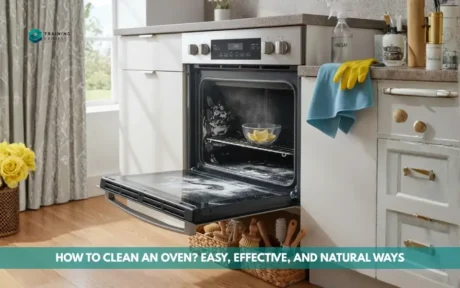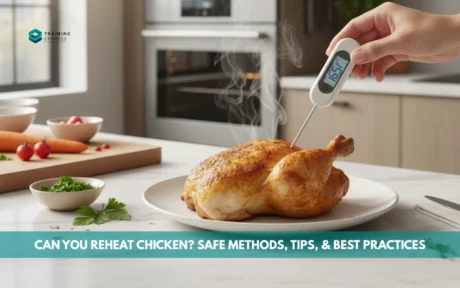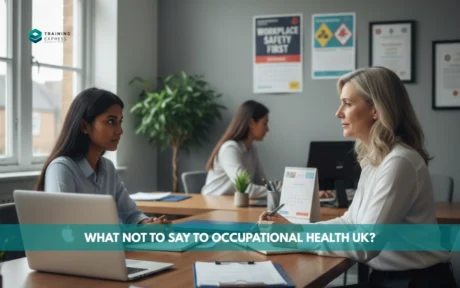
![What Do UK Food Hygiene Ratings Mean [Fully Explained]](https://trainingexpress.org.uk/wp-content/uploads/2023/02/What-Do-UK-Food-Hygiene-Ratings-Mean-Fully-Explained.png)
Each year, an estimated 380,000 foodborne illnesses occur in the UK. We must focus more on food hygiene and safety to reduce this number. Unfortunately, we cannot determine hygiene standards by simple observation. Fortunately, authorities have developed a system of food hygiene ratings. It helps establish an uncompromised food standard across food businesses. This article will extensively talk about the UK food hygiene ratings.
Table of Contents
What is Food Hygiene?
Simply put, food hygiene is the activity of food manufacturing businesses to protect public health from any dangers of foodborne diseases caused by microbial contamination. Importantly, food hygiene procedures concern the biological side of keeping food safe. In addition, these procedures and principles keep food operations clean and healthy. Hygiene procedures may include handling, transportation, secure food storage, and processing supplies.
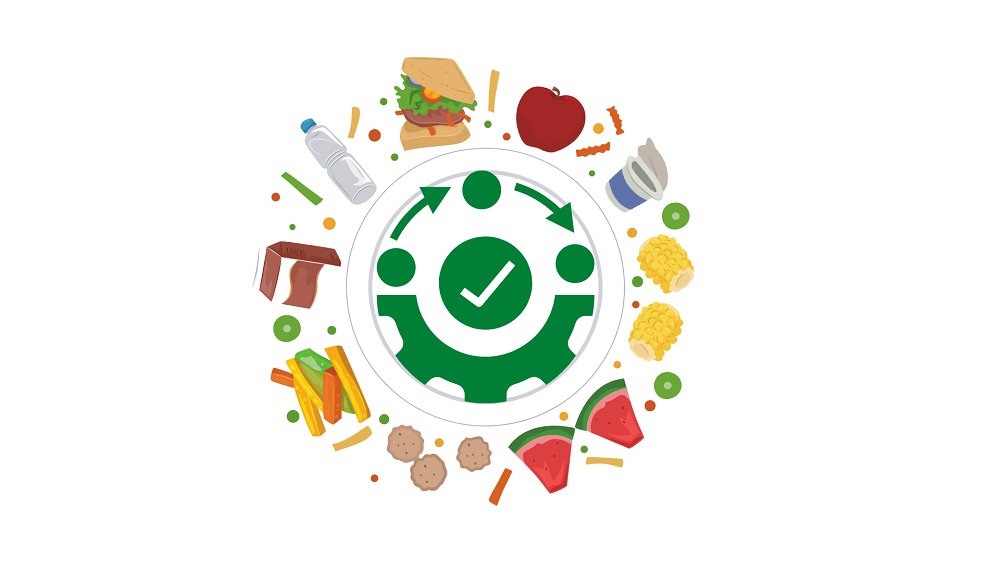
What are Food Hygiene Ratings?
Ratings are a reflection of the food hygiene standards. For example, a food safety officer gives food hygiene ratings during his examination. By law, food businesses must follow food hygiene standards at all times.
Food hygiene ratings encompass the following things.
- Food Handling
- Food Storage
- Food Preparation
- Facility Hygiene
- Food Safety Management
However, the food hygiene ratings do not include nutritional quality, customer service, culinary expertise, or comfort information.
What is the Food Hygiene Ratings Scheme?
In light of the discovery during the inspection, the rating will indicate the hygiene standard of a food business. The ratings are accessible online. In addition, you’ll find the ratings on labels placed on commercial premises. Also, you can see the inspection date by the local authority’s food safety officer on the reverse of the label or in the online rating.
A local authority food safety officer inspects a business to ensure that it follows the food hygiene laws and that the food is safe to eat. Mainly, the inspecting officer will apply food hygiene ratings to the following places.
- Restaurants
- Bars
- Cafés
- Takeaways
- Food vans
- Food stalls
- Canteens
- Hotels
- Supermarkets
- Food shops
- Schools
- Hospitals
- Care facilities
Officers will inspect how the business handles its food hygienically. For example, they will check how the food is prepared, cooked, reheated, chilled, and stored. In addition, hygiene applies to the physical state of the company, such as cleanliness, layout, lighting, ventilation, and pest control. Finally, a food safety officer inspects the methods of keeping food safe. The methods may include processes, training, and systems to guarantee proper hygiene.
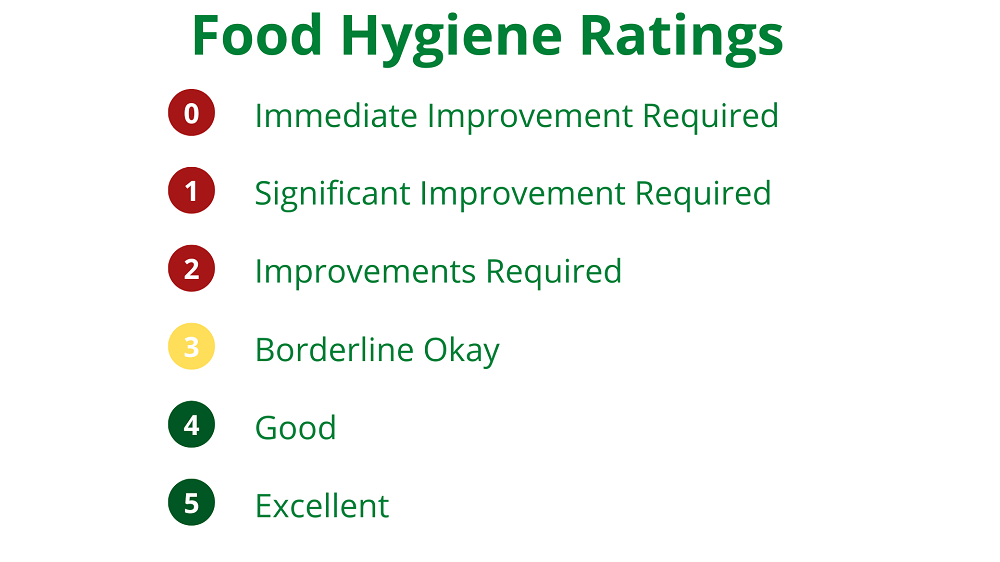
How Many Food Hygiene Ratings are There?
Food businesses in the UK must comply with their local authorities. So, failure to do so might result in significant penalties, jail time, and business closure. Following registration, a local authority food safety officer from the environmental health department will inspect the business.
Food Hygiene Ratings in England, Wales, and Northern Ireland
A food hygiene grade of 0 to 5 is awarded in England, Wales, and Northern Ireland.
5 – Excellent.
4 – Good.
3 – Borderline Okay.
2 – Improvements Required.
1 – Significant Improvement Required.
0 – Immediate Improvement Required.
Food Hygiene Ratings in Scotland
In Scotland, the local authority will award one of the following ratings.
Pass
A “Pass” signifies that the food business satisfies most legal standards. In addition, the conditions discovered and management methods are in place to guarantee safe food.
Improvement Required
If a company fails to meet legal standards, the food safety officer will give an “Improvement Required” certificate.
Exempt Premises
Some premises may be listed as food businesses, but consumers are unlikely to see them as such. So, examining such places will reveal a minimal risk to food safety. If the business agrees, no certificate will be awarded to them. In addition, the local authorities’ website will display that the business is currently excluded from the Food Hygiene Ratings Scheme.
Awaiting Inspection
A temporary certificate will be awarded if a business still needs to be examined. On the website, the authority will show this as “Awaiting Inspection”. Additionally, premises that have changed ownership will also need to be re-inspected.
How are the Food Hygiene Ratings Calculated?
It is crucial to note that ratings represent a snapshot of the food hygiene standards discovered during the inspection. So, businesses must follow food hygiene laws at all times, not only during inspections. Take our Food Hygiene Legislation and Foodborne Diseases Course and learn to maintain the best hygiene standards for your business.

A food safety officer inspects each establishment covered by the Food Hygiene Ratings Scheme during an “unannounced” visit. In addition, he will check and analyse how food is being handled, stored, and cooked. Moreover, the visit would also cover inspecting the facilities’ cleanliness and the hygiene maintenance systems.
The inspecting officer follows a specific protocol to determine a food hygiene rating. For example, he may use the Food Law Code of Practice. It asks for the following requirements.
- How does the business handle food hygiene systematically?
- Is the building of the premises in good condition?
- Management and Procedures Documentation
The Food Hygiene Ratings
The food safety officer will give the business a score for each category.
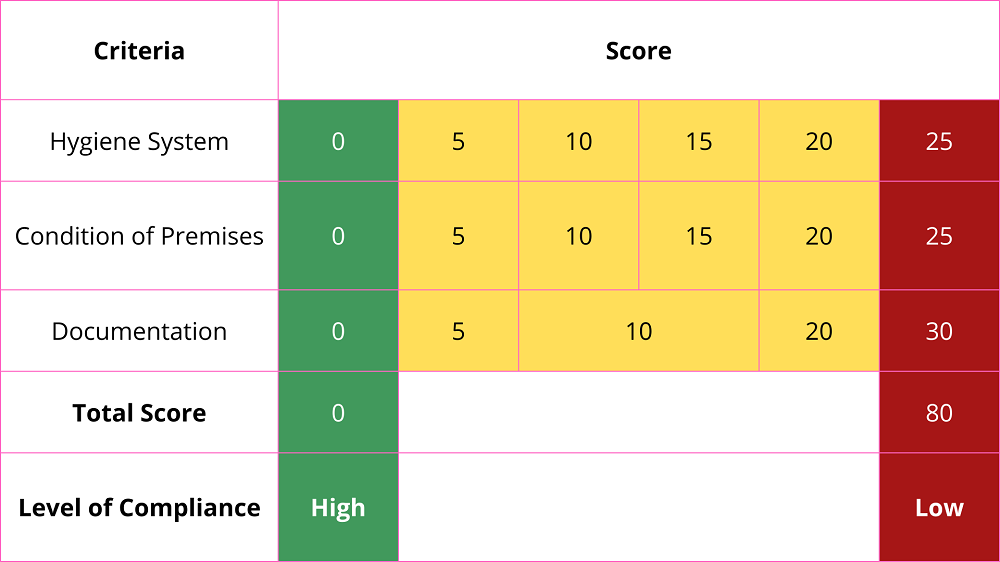
The ratings are based on the business’s overall performance and total score. Most importantly, ratings rely on the area that requires the most significant improvement. Also, the business may do better in some areas than others.
A food business needs a score of no more than 5 in any of the three categories to receive the highest rating. Every business should strive to get the highest rating. Every time the local authority schedules an inspection, you’ll receive a new rating.

How to Achieve a Top Score in Food Hygiene Ratings
You can do the following tasks to obtain the highest possible rating.
First, examine your most recent food hygiene inspection report. Next, ensure that you’ve completed all the necessary steps to meet regulatory criteria. If you need help finding your most recent report, contact the authority. They will send you a copy.
In addition, ask the food safety officer for help if you still need to obtain the highest grade on your next inspection. Also, you may have questions about the modifications you need to do to achieve a higher rating.
Finally, ensure that you and your employees continue to follow all areas of food hygiene regulations.
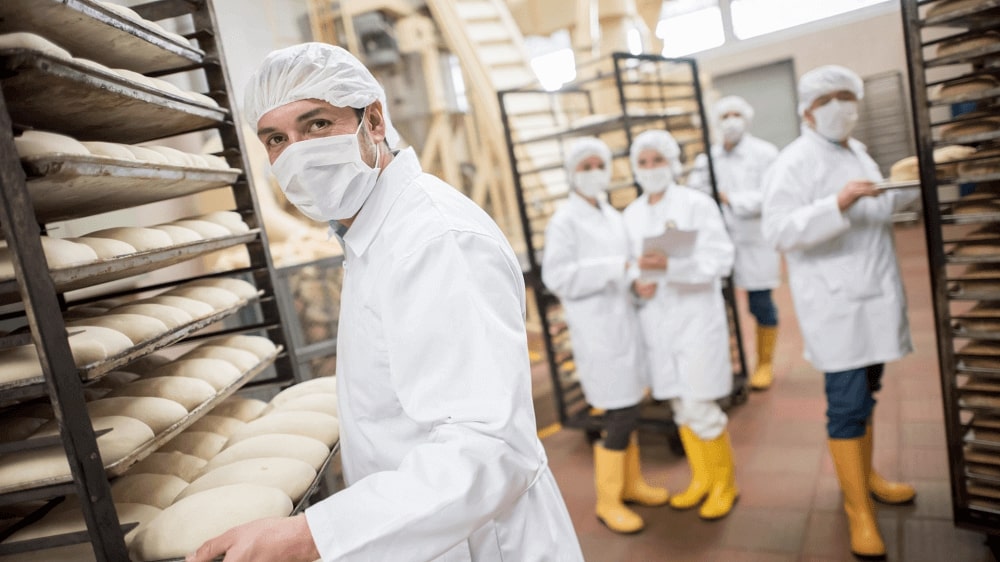
Display of Food Hygiene Ratings [Stickers]
Your business place may be a restaurant, coffee shop, or takeout. Whatever the place is, you must display your food hygiene rating sticker where customers can clearly see it. For example, you may put it on your entrance or in a window. Most customers prefer to see the food hygiene ratings when they choose a place for a meal. Therefore, placing the stickers in the right places reassures them that you take food hygiene seriously.
However, you may contact the local food safety office if you lose your sticker. They can provide it to you again.
In addition, an excellent spot to promote your food hygiene rating is on the menu. So, it would help if you were glad to display your rating whether your menu is on the table, in the window, on a board outside, or online.
Display of Food Hygiene Ratings [Online]
Food businesses must display their food hygiene ratings on their premises and online. The positioning of online displays should adhere to food hygiene principles. Most importantly, you should clearly show the food hygiene ratings on the website. It will ensure business transparency to your customer when they reach a page.
In addition, the ratings should be at a size that allows them to read them easily. Avoid lowering the image’s size or resolution to the point where the rating is pixelated or challenging.
Before a customer chooses food or places an order, businesses have to show ratings somewhere. Even if a consumer doesn’t visit your homepage, you should consider the many methods they could use to navigate your website and ensure the rating is displayed. However, if your food business has completed the registration but has not yet received a rating, you may indicate this online by stating “awaiting inspection”.
Food Hygiene Ratings on Social Media
The food industry widely uses social media to market items and accept online purchases. Your social media business sites could be your customers’ primary point of sale. As a result, the food hygiene ratings should be easily viewable and easily readable before the end of placing or getting an order. It would help if you shared your rating on every social media platform where you have a presence. Also, the same applies to platforms where customers may place orders through messaging services.
For example, you may include the appropriate food hygiene ratings on your Facebook Cover Photo. In this case, to avoid conflict with your profile image, you should put the ratings on the right side of the Cover.
How to Get 5-Star Food Hygiene Ratings?
As a food business manager or owner, your priority would be getting the top food hygiene ratings. You have to maintain various things to do so.
Separate Sections for Raw & Prepared Food
Avoid making typical blunders like keeping raw foods near prepared foods. Remember to store uncooked and unwashed vegetables separately from other raw items, such as meat and fish. Keep the storage system adequately marked. In addition, it should feature a use-by-date indicator. Remember, you should only place that food on the floor instead of racks.
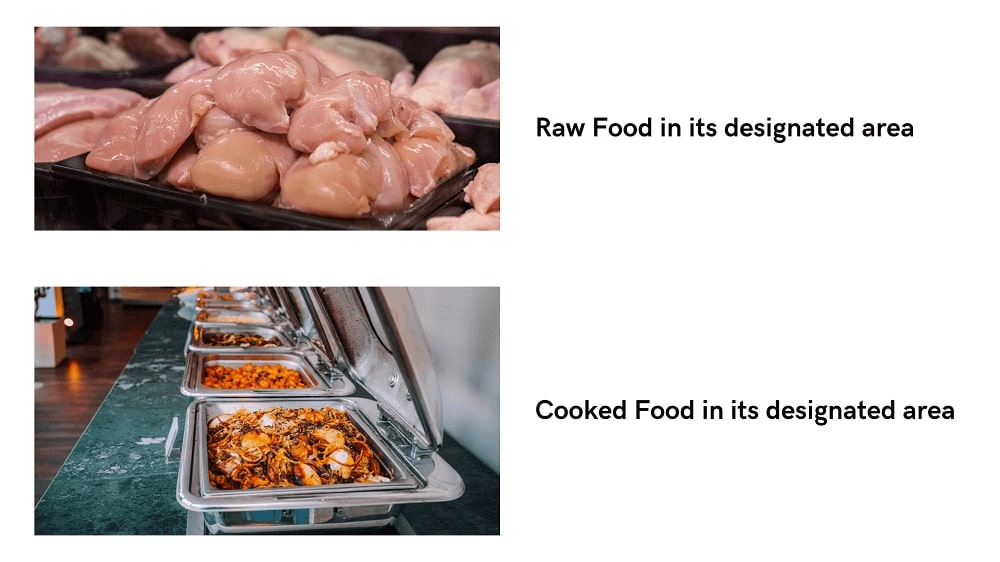
Avoid washing raw and prepared food in the same sink to lower the chance of cross-contamination. You’ll need to create and follow a timetable for food preparation if you operate in a limited location and need access to several sinks. Also, prepare ready-to-eat items first and carefully clean the space before adding fresh veggies.
Ensure that your oversized kitchen has distinct areas for working with raw fish, raw meat, raw veggies, and ready-to-eat items. If you’re working in a limited area, schedule your workday appropriately. Prepare different meals at other times of the day, and thoroughly clean your utensils and surfaces between each stage of preparation.
Neat and Clean Kitchen
It should go without saying, but it’s always preferable to err on caution when it comes to keeping your workstations tidy. Establish a cleaning plan and stick to it. In addition, organise each activity into smaller ones and ensure the workstation is cleaned consistently daily. Also, ensure that antibacterial soap is constantly available and that the handwashing sink is maintained clean. Furthermore, individuals working in the kitchen should have fast access to blue rolls to mop up spills or dry their hands quickly.
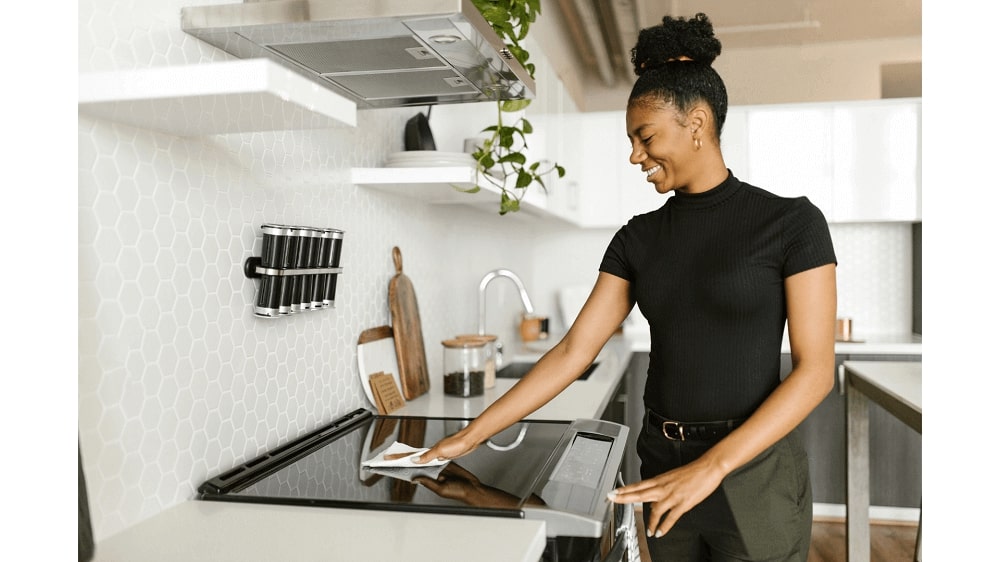
As often as possible, empty the trash, and never let it overflow. Ovens should be cleansed once a week, while refrigerators should always receive a complete cleaning at the end of a month.
Staff Instructions & Training
Any kitchen personnel should receive rigorous instruction on preparing food properly and reducing the danger of cross-contamination. So, employees should be informed of proper hand washing techniques, use protective gear and head coverings, and refrain from wearing watches or jewellery in the kitchen. Also, everybody who is supposed to perform kitchen tasks should receive frequent refresher training. Ensure the training is customised for your company.
Documentation
As mentioned earlier, you must show that current records of all the actions are being retained. In addition, a food safety policy should be written, along with daily check sheets for food temperatures and freezer and refrigerator conditions. Any documentation deficiencies will impact the final ranking.
How Do I Order Food Hygiene Ratings Stickers?
You need to contact your local authorities to order food hygiene stickers. However, first, you need to request a visit from a food safety officer to get a rating. Once your rating is ready, the authorities will provide you with the stickers.
Food Hygiene Ratings Stickers should adhere to all the Food Standard Agency guidelines. In addition, these stickers will contain trademarked images. Food businesses should obtain stickers only through the scheme’s local authorities.
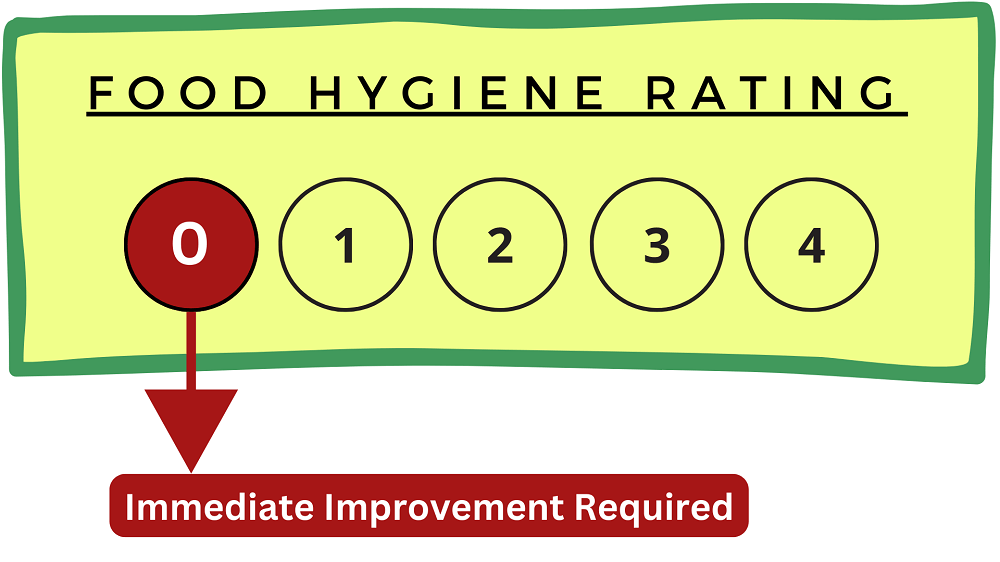
Avoid purchasing stickers from any source other rather than the local authorities. Also, restrain yourself from using invalid ratings. The Food Standard Agency will ask you to cease using invalid images or ratings if you do it. All in all, they may pursue legal action against you.
FAQs
Though we have given a comprehensive analysis of food hygiene ratings, there might still be some questions in your mind. Let’s address them and get the answers.
Why are Food Hygiene Ratings on the Premises Different From Their Online Counterpart?
There might be brief discrepancies between a premises sticker rating and its online rating for legitimate causes. For example, the local authority could be in the process of adding new ratings to its website. On the other hand, the business might have4 challenged its most recent rating and is awaiting the decision.
Even if a company has the highest rating, there may be a brief lag while the local authority updates the website. Ratings are posted by local authorities at least once every 28 days. You must contact the local officer in charge of inspecting the business if you are still looking for a rating.
Suppose you are worried that a food place is purposefully showing a higher rating than the one online to imply it has more significant hygienic standards than it does. In that case, you could also contact the local authority.
How Can I Check My Food Hygiene Rating?
You can check your food hygiene ratings on the Food Standard Agency website. Put down your business name and area; you’ll find your ratings. Moreover, you may download your report if you want a document.
What are Scores on the Doors?
“Scores on the Doors” is another terminology for food hygiene ratings. Local authorities utilise the Scores on the Doors hygiene rating system to assess how food establishments handle, prepare, and store the food they serve to the general public. The program also covers eateries, bars, cafes, takeout, motels, supermarkets, and other food stores. Keep in mind that the “Food Hygiene Ratings Scheme” and “Scores on the Doors” are the same.
How Long Does a Food Hygiene Rating Last?
The interval between inspections ranges from six months for the businesses with the highest risk to two years for those with lower risk. The time between checks may exceed two years for some businesses with less risk. However, there may be some exceptions.
Local authorities may keep an eye on businesses in different ways in between inspections to ensure they uphold hygienic standards. The officer will conduct an inspection and give the business a new grade if these checks turn up anything that would suggest that hygiene standards have fallen.
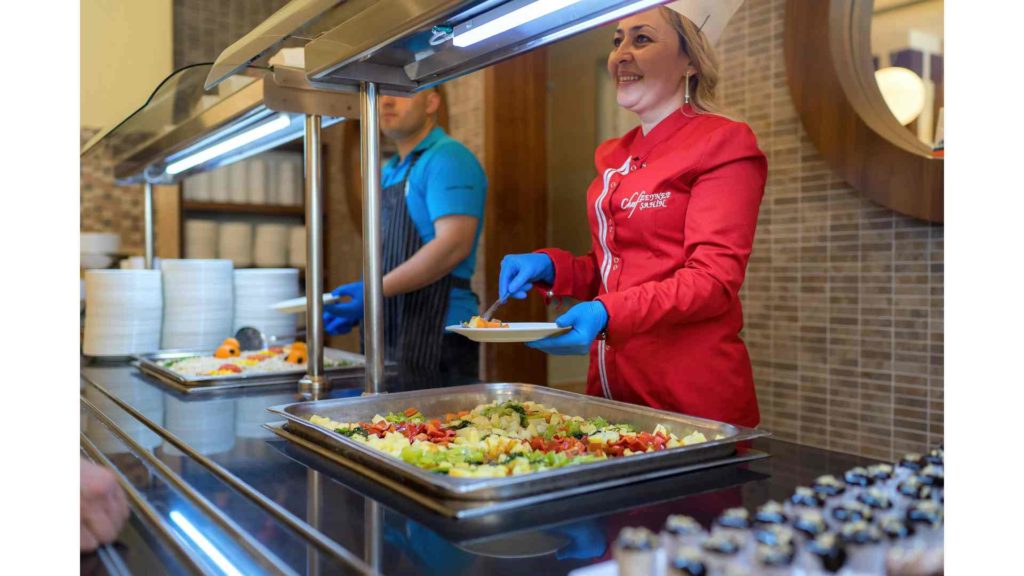
Summary
Food hygiene ratings reveal the hygienic standards of the food business. Additionally, reviews encourage businesses to handle food with more care. A food hygiene inspection shouldn’t worry you if you keep flawless hygienic status in your firm. Remember that ratings reflect the general level of cleanliness at your business.
The food’s dietary value, the restaurant’s ambience, and other factors are still requirements you must meet if you want to expand your clientele. However, a food hygiene rating of 5 will reassure your customers that they are consuming the most hygienic meals. It will also help your business in other areas. Train your employees and food handlers to preserve the hygiene standards in your business with our Food Hygiene Legislation and Foodborne Diseases Course. We guarantee that you’ll not regret it!
- Available Courses
- Animal care10
- Design28
- Training9
- Accounting & Finance Primary49
- Teaching & Academics Primary37
- Teaching23
- Quality Licence Scheme Endorsed171
- Law10
- IT & Software229
- Job Ready Programme52
- Charity & Non-Profit Courses28
- HR & Leadership4
- Administration & Office Skills4
- Mandatory Training36
- Regulated Courses4
- AI & Data Literacy24
- Health and Social Care290
- Personal Development1622
- Food Hygiene117
- Safeguarding80
- Employability287
- First Aid73
- Business Skills293
- Management425
- Child Psychology40
- Health and Safety531
- Hospitality28
- Electronics31
- Construction62
- Career Bundles201
- Marketing39
- Healthcare172

 Food Hygiene
Food Hygiene Health & Safety
Health & Safety Safeguarding
Safeguarding First Aid
First Aid Business Skills
Business Skills Personal Development
Personal Development
